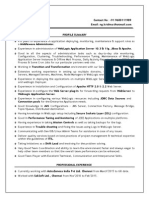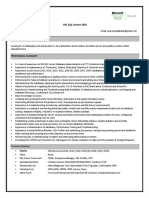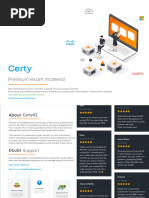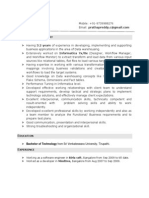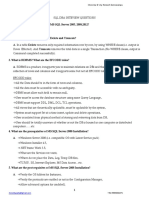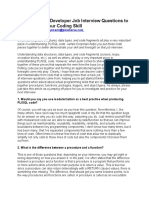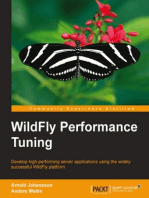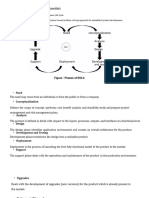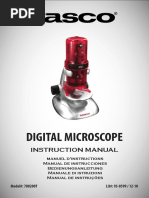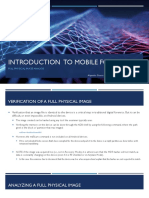Programming Abstraction CHO CS179
Uploaded by
jyotiraditya0709.be21Programming Abstraction CHO CS179
Uploaded by
jyotiraditya0709.be21Course Plan
A. Course Handout updated on 27th June, 2023
Institute/School Name Chitkara University Institute of Engineering and Technology
Department Name Computer Science & Engineering
Programme Name Bachelor of Engineering, Computer Science & Engineering
Course Name Programming Abstractions Session 2023-2024
Course Code CS179 Semester/Batch 5th/2021
L-T-P (Per Week) 8-0-0 Course Credits 04
Course Coordinator Dr. Tejinder Kaur
1. Objectives of the Course
The course provides a wide scope of learning & understanding of the subject and the main objectives of the
course are:
• To make students ready for the programming jobs in software-product based companies.
• Strong problem-solving skills and computer science fundamentals.
• Identify importance of object-oriented programming and difference between structured oriented and
object-oriented programming features.
• Exercise and reinforce prior programming knowledge to effectively code standard problems and
algorithms with optimized complexity.
2. Course Learning Outcomes
After completion of the course, students will be able to do the following:
CO1: Understand the basic concept of object-oriented programming such as array, polymorphism,
encapsulation etc.
CO2: Exemplify the concept of data structure and able to identify appropriate data structure while designing
the algorithms.
CO3: Implement a well-structured, robust computer program.
CO4: Analysis the concept of Bit Masking, recursion and dynamic programming to implement it on real time
applications.
CO5: Reviewing the concept of backtracking and object-oriented dynamic programming to implement on
software based real time applications.
CO-PO Mapping Grid
Course PO1 PO2 PO3 PO4 PO5 PO6 PO7 PO8 PO9 PO10 PO11 PO12
Outcomes
CO1 M
CO2 H H H H M
CO3 H H
CO4 H H H M M
CO5 H H M M H H
3. Recommended Books (Reference Books/Text Books):
RB1: Object Oriented Programming with C++ by E Balagurusamy, 2001, Tata McGraw-Hill.
RB2: Object Oriented Programming in Turbo C++ by Robert Lafore, 1994, The WAITE Group Press.
RB3: Complete Reference C++, Herbert Schlitz, TMH.
RB4: Cracking the Coding interviews 6th edition by Gayle Laakmann McDowell
RB5: Java: The Complete Reference by Herbert Schildt, 9th Edition, Oracle Press and McGraw Hill Publishers.
RB6: Data Structures and Algorithms Made Easy by Narasimha Karumanchi
Programming Abstractions / CS179 Page 1 of 8
Course Plan
RB7: DATA STRUCTURES AND ABSTRACTIONS WITH JAVA, 5TH EDITION, Frank Carrano, Timothy Henry,
Pearson Publications.
RB8: Programming Abstractions in C by Eric S. Roberts 1stEdition, Pearson Publication
RB9: Data Structures using Java by Robert Lafaore, 2nd Edition, Sams Publishing, ISBN13: 978-0672324536
4. Other readings and relevant websites:
S. No. Links of Journals, Magazines, websites and Research Papers
1 https://www.tutorialspoint.com/java/java_quick_guide.htm
2 https://thecleverprogrammer.com/2020/10/25/the-fundamentals-of-c-programming-
language/?msclkid=333199a8bece11ec8c83bf5534909d32
3 https://www.javatpoint.com/cpp-array-of-pointers?msclkid=966ad51dbece11ec949a8b0b78205a7d
4 https://www.w3schools.com/cpp/default.asp
5 https://www.programiz.com/cpp-programming/variables-literals
6 https://www.geeksforgeeks.org/array-data-structure/?ref=shm
7 https://www.geeksforgeeks.org/bitmasking-and-dynamic-programming-set-1-count-ways-to-assign-
unique-cap-to-every-person/
8 https://www.geeksforgeeks.org/recursion-practice-problems-solutions/
9 https://www.youtube.com/watch?v=IJDJ0kBx2LM
10 https://www.simplilearn.com/tutorials/data-structure-tutorial/backtracking-algorithm
11 https://towardsdatascience.com/space-and-time-complexity-in-computer-algorithms-
a7fffe9e4683?gi=287c4af61600
12 https://www.educative.io/blog/object-oriented-programming
13 https://medium.datadriveninvestor.com/mastering-object-oriented-programming-in-c-672773d87388
14 https://www.codesdope.com/cpp-virtual-and-abstract/
15 https://www.studytonight.com/cpp/abstract-class-and-pure-virtual.php
16 http://www.nou.ac.in/Online%20Resourses/01-09/bca5.pdf
17 http://www.btechsmartclass.com/data_structures/stack-using-linked-list.html
18 https://iq.opengenus.org/implement-stack-using-array-and-linked-list/
19 https://coderbyte.com/algorithm/implement-queue-using-two-stacks
20 https://www.programiz.com/dsa/deque
21 https://opendsa-
server.cs.vt.edu/ODSA/Books/CS3/html/StackLinked.html#:~:text=Linked%20Stack%20Implementation,o
f%20zero%20or%20one%20elements.
22 https://enos.itcollege.ee/~jpoial/allalaadimised/reading/Java-Abstraction.pdf
23 https://www.e-booksdirectory.com/details.php?ebook=10953
24 https://inst.eecs.berkeley.edu/~cs61a/su12/lec/notes/data.html
25 https://cs.stanford.edu/people/eroberts/books/ProgrammingAbstractionsInJava/index.html
26 https://www.youtube.com/watch?v=oBt53YbR9Kk
27 https://www.mathsisfun.com/games/towerofhanoi.html
28 https://prepinsta.com/c-program/implementation-of-queues-using-linked-list/
5. Recommended Tools and Platforms
C++Builder, Visual Studio Code, GCC Compiler, Eclipse, J2EE, vlab.
6. Course Plan:
Lecture Topics Recommended Book /
Number Other reading material
1–3 Revision - Java Link 1, RB5
4–7 Arrays - Algorithms such as Linear Search, Binary Search, Sorting, Link 2, RB7
Maximum Subarrays, and Searching
8 – 12 Strings - String Class and its useful methods. Concept of immutability, Link 3, RB6
memory diagram, intern pool, use of new keyword in generating strings.
Programming Abstractions / CS179 Page 2 of 8
Course Plan
Problem solving in which various problems will be covered using String
13 - 15 Bit masking - In this section, we will understand how Bitwise operators Link 4, RB8
like AND, OR, XOR, and NOT to work on machine code to help write the
programs that works faster, since computer understands machine code.
This concept is also very useful in Recursion as well as Dynamic
programming advanced concepts.
16 – 18 Recursion, Need of recursion, with examples problems. Link 5, GFG, RB4
ST-I (Syllabus covered from 1-18 lectures)
19 – 21 Deep Dive into Recursion – More complex recursive applications using Link 6, RB6
arrays and strings.
22 – 25 Backtracking and its applications Link 10, RB6
26 – 30 Time and Space Complexities – Concept and Calculations along with Link 8, RB4, RB8
special emphasis on Algorithms and data structures studies thus far.
31 – 36 Data Structures and OOPS – Types and Examples of Data structures with Link 12, RB1, RB9
their programming abstractions in context with typical concepts of
Object-Oriented Paradigm
37 – 40 OOPS – Encapsulation, Inheritance, Virtual base class, Overriding member Link 13, RB2, RB9
functions
41 – 44 Virtual Functions and Polymorphism: Concept of Binding - Early binding Link 14, RB1, RB2
and late binding
45 – 48 Virtual functions, Pure virtual functions, Abstract classes Link 15, RB1, RB2
49 – 50 Exception Handling, Templates and Generic Programming Link 16, RB1, RB2
51 – 55 Linked List – types, implementation, examples and applications with in- Link 17, RB9, Javatpoint
context Programming abstractions.
56 – 60 Stack and its operations with Hands-on implementation of its Link 18, Programiz
applications.
61 – 66 Some typical problems using Stack such as Histogram Area, Stock Span, Link 19, GFG,
andBalanced Parentheses etc. HackerRank
67 – 70 Stacks implementation using Arrays, Linked Stacks Link 17 to Link 20, GFG
ST-II (Syllabus covered from 19-70 lectures)
71 – 78 2 stacks in an Array, k stacks in an array, Tower of Hanoi, Queues Link 18, Link 19, Link 27,
implementation using Arrays, Linked Queues Link 28, RB4
79 – 86 Circular Queues, Implement Queue using Stacks, Dequeues Link 19, Link 20, RB6
87 – 90 Revision and Queries Doubt Clearance window, Out of the Box stuff along Link 26, RB4, RB6
with Beyond Curricula Topics such as Dynamic Programming.
ETE (Syllabus covered from 1-90 lectures)
7. Delivery/Instructional Resources
Lecture PPT Industry Expert Web Audio-Video
Number Topics (link of ppts on Session References
the central (If yes: link of ppts
server) on the central
server)
1–3 Revision - Java https://cs.calvi
n.edu/activitie
s/books/java/i
ntro/1e/PPSlid
Programming Abstractions / CS179 Page 3 of 8
Course Plan
es/chap02.ppt
4–7 Arrays - Algorithms such as https://cse.iitk https://personal.u https://ww
Linear Search, Binary Search, gp.ac.in/~bivas tdallas.edu/~daes w2.cs.uh.ed
Sorting, Maximum Subarrays, m/pds_notes/ cu/max- u/~rizk/cosc
and Searching
search_sort_v subarray.pptx 2430/slides/
1.ppt 07-sort-99-
intro.ppt
8 – 12 Strings - String Class and its http://www.cs https://courses.cs.
useful methods. Concept of .nthu.edu.tw/~ washington.edu/c
immutability, memory d9662827/cs3 ourses/cse331/11
diagram, intern pool, use of
40100_97/11_ sp/lectures/slides/
new keyword in generating
strings. Problem solving in String.ppt 07-mutation.ppt
which various problems will
be covered using String
13 - 15 Bit masking - In this section, https://www.s
we will understand how cribd.com/doc
Bitwise operators like AND, ument/420973
OR, XOR, and NOT to work on
335/Lecture-
machine code to help write
the programs that works 01-Bitmasking
faster, since computer
understands machine code.
This concept is also very
useful in Recursion as well as
Dynamic programming
advanced concepts.
16 – 18 Recursion, Need of recursion, https://www.c https://cs.fit.edu/
with examples problems. se.unr.edu/~b ~pkc/classes/cse1
ebis/CS308/Po 001/slides/ch11.p
werPoint/Recu pt
rsion.ppt
19 – 21 Deep Dive into Recursion – https://people
More complex recursive .cs.umass.edu/
applications using arrays and ~moss/187/lec
strings.
tures/lecture-
h-
recursion.ppt
22 – 25 Backtracking and its https://course
applications s.cs.washingto
n.edu/courses
/cse373/15su/l
ectures/lectur
e22.pptx
26 – 30 Time and Space Complexities https://sites.cs https://www.cs.b
– Concept and Calculations .ucsb.edu/~sur ham.ac.uk/~jxb/D
along with special emphasis i/cs130a/intro- SA/dsa.pdf
on Algorithms and data
1.ppt
structures studies thus far.
31 – 36 Data Structures and OOPS – https://iare.ac. https://www.cet.e
Types and Examples of Data in/sites/defaul du.in/noticefiles/2
structures with their
Programming Abstractions / CS179 Page 4 of 8
Course Plan
programming abstractions in t/files/PPT/JAV 85_OOPS%20lectu
context with typical concepts A-PPT'S.pdf re%20notes%20C
of Object-Oriented Paradigm omplete.pdf
37 – 40 OOPS – Encapsulation, https://cs.slu.e
Inheritance, Virtual base du/~chambers
class, Overriding member /spring17/320
functions
0/schedule/ch
apter9.ppt
41 – 44 Virtual Functions and http://web.cse https://ecs.syr.ed
Polymorphism: Concept of .ohio- u/faculty/fawcett/
Binding - Early binding and state.edu/~so Handouts/cse775/
late binding,
undarajan.1/c Presentations/late
ourses/45922/ binding.ppt
WeiDu/lecture
7.ppt
45 – 48 Virtual functions, Pure virtual https://course https://www.cs.cc
functions, Abstract classes s.cs.washingto u.edu.tw/~naiwei/
n.edu/courses cs2160/chap15cp
/cse374/21au/ p3rd.ppt
lectures/lectur
e23.pptx
49 – 50 Exception Handling, https://techiefood
Templates and Generic 4u.files.wordpress
Programming .com/2018/10/uni
t_4_v_3-2.pptx
51 – 55 Linked List – types, https://cse.iitk
implementation, examples gp.ac.in/pds/s
and applications with in- emester/2016
context Programming
a/JM/Wk11-
abstractions.
linkedlist.ppt
56 – 60 Stack and its operations with https://www.c
Hands-on implementation of s.utexas.edu/~
its applications. scottm/cs307/
handouts/Slid
es/Topic15Sta
cks.ppt
61 – 66 Some typical problems using https://ww
Stack such as Histogram Area, w.geeksforg
Stock Span, andBalanced eeks.org/ap
Parantheses etc.
plications-
advantages-
and-
disadvantag
es-of-stack/
67 – 70 Stacks implementation using https://www.c
Arrays, Linked Stacks s.bu.edu/fac/g
kollios/cs113/
Slides/LinkedS
Programming Abstractions / CS179 Page 5 of 8
Course Plan
Q.ppt
71 – 78 2 stacks in a Array, k stacks in https://cse.iitk https://ww
an array, Tower of Hanoi, gp.ac.in/pds/s w.codingninj
Queues implementation emester/2017 as.com/studi
using Arrays, Linked Queues
s/DSM/resour o/library/tw
ces/slides/13 o-stacks-in-
%20Stacks%20 an-array
and%20Queue
s.pptx
79 – 86 Circular Queues, Implement https://course https://www.cse.i
Queue using Stacks, s.cs.washingto itd.ac.in/~mohant
Dequeues n.edu/courses y/col106/Resourc
/cse373/12sp/ es/Week2-stacks-
lectures/03- queues.pptx
28-queues/02-
queues.ppt
87 – 90 Revision and Queries Doubt https://www2
Clearance window, Out of the .cs.sfu.ca/~bin
Box stuff along with Beyond ay/2018/409/
Curricula.
DynamicProgr
amming.pptx
8. Action plan for different types of learners
Slow Learners Average Learners Advanced Learners
• Remedial Class for slow learners • Doubt Class for average learners • Certification exams will be
to revise specific topics. • Doubts of individual student will be offered to interested
• Individual feedback of each resolved. students.
slow learner.
9. Evaluation Scheme & Components:
Evaluation Type of Component No. of Weightage of Mode of
Component Assessments Component Assessment
Component 2 Subjective Test/Sessional Tests (STs) 02* 40% Offline
Component 3 End Term Examinations 01 60% Offline
Total 100%
*Out of 2 STs, the ERP system automatically picks the best 1 ST marks for evaluation of the STs as final marks.
10. Details of Evaluation Components:
Evaluation Description Syllabus Covered Timeline of Examination Weightage
Component (%) (%)
th
ST 01 Up to 20% 4 Week
Component 2 40%
ST 02 21% - 80% 10th Week
Component 3 End Term Examination* 100% 12th Week 60%
Total 100%
Programming Abstractions / CS179 Page 6 of 8
Course Plan
*As per Academic Guidelines minimum 75% attendance is required to become eligible for appearing in the
End Semester Examination.
11. Syllabus of the Course:
Lecture Topics No. of Lectures Weightage %
Number
1–3 Revision - Java 3
4–7 Arrays - Algorithms such as Linear Search, Binary Search, Sorting,
4
Maximum Subarrays, and Searching
8– 12 Strings - String Class and its useful methods. Concept of
immutability, memory diagram, intern pool, use of new keyword in
4
generating strings. Problem solving in which various problems will
be covered using String 20 %
13 - 15 Bit Masking - In this section, we will understand how Bitwise
operators like AND, OR, XOR, and NOT to work on machine code to
help write the programs that works faster, since computer 4
understands machine code. This concept is also very useful in
Recursion as well as Dynamic programming advanced concepts.
16 – 18 Recursion, Need of recursion, with examples problems. 3
19 – 21 Deep Dive into Recursion – More complex recursive applications
3
using arrays and strings.
22 – 25 Backtracking and its applications 4
26 – 30 Time and Space Complexities – Concept and Calculations along with
special emphasis on Algorithms and data structures studies thus far. 5
25 %
31 – 36 Data Structures and OOPS – Types and Examples of Data structures
with their programming abstractions in context with typical 6
concepts of Object-Oriented Paradigm
37 – 40 OOPS – Encapsulation, Inheritance, Virtual base class, Overriding
4
member functions
41 – 44 Virtual Functions and Polymorphism: Concept of Binding - Early
4
binding and late binding,
45 – 48 Virtual functions, Pure virtual functions, Abstract classes 4
49 – 50 Exception Handling, Templates and Generic Programming 2 25 %
51 – 55 Linked List – types, implementation, examples and applications with
in-context Programming abstractions. 5
56 – 60 Stack and its operations with Hands-on implementation of its
5
applications.
61 – 66 Some typical problems using Stack such as Histogram Area, Stock
Span, andBalanced Parentheses etc. 5
67 – 70 Stacks implementation using Arrays, Linked Stacks 5 30 %
71 – 78 2 stacks in a Array, k stacks in an array, Tower of Hanoi, Queues
implementation using Arrays, Linked Queues 8
79 – 86 Circular Queues, Implement Queue using Stacks, Dequeues 8
87 – 90 Revision and Queries Doubt Clearance window, Out of the Box stuff
4
along with Beyond Curricula.
Programming Abstractions / CS179 Page 7 of 8
Course Plan
This Document is approved by:
Designation Name Signature
Course Coordinator Dr. Tejinder Kaur
Head Academic Delivery Dr. Susheela Hooda
Dean 3rd Year Dr. Rupali Gill
Date (DD/MM/YYYY) 27/06/2023
Programming Abstractions / CS179 Page 8 of 8
You might also like
- Apache Cassandra Administrator Associate - Exam Practice TestsFrom EverandApache Cassandra Administrator Associate - Exam Practice TestsNo ratings yet
- ? Create The ROOT - DEPTH Table - ESS-DWW Courseware - Snowflake University - On-DemandNo ratings yet? Create The ROOT - DEPTH Table - ESS-DWW Courseware - Snowflake University - On-Demand7 pages
- (English (Auto-Generated) ) Building End-to-End Delta Pipelines On GCP (DownSub - Com)No ratings yet(English (Auto-Generated) ) Building End-to-End Delta Pipelines On GCP (DownSub - Com)24 pages
- ADBMS Parallel and Distributed DatabasesNo ratings yetADBMS Parallel and Distributed Databases98 pages
- DB Related: 'Db3' 'E:/Sql - Dbs/Db3.Mdf'No ratings yetDB Related: 'Db3' 'E:/Sql - Dbs/Db3.Mdf'8 pages
- Azure - Senior SQL Server Database Administrator - SagarPatil_12YrsNo ratings yetAzure - Senior SQL Server Database Administrator - SagarPatil_12Yrs3 pages
- Bandwidth Reference Brent Ozar Unlimited LegalNo ratings yetBandwidth Reference Brent Ozar Unlimited Legal1 page
- COG-632: IBM Cognos 10 BI Metadata Model DeveloperNo ratings yetCOG-632: IBM Cognos 10 BI Metadata Model Developer18 pages
- Azure Data Factory Monitoring Best PracticesNo ratings yetAzure Data Factory Monitoring Best Practices9 pages
- Using Sysdig To Troubleshoot Like A BossNo ratings yetUsing Sysdig To Troubleshoot Like A Boss17 pages
- Thanks For Downloading. Enjoy The ReadingNo ratings yetThanks For Downloading. Enjoy The Reading31 pages
- 70-764 - Administering A SQL Database InfrastructureNo ratings yet70-764 - Administering A SQL Database Infrastructure8 pages
- Devops Engineer (5-10 Years' Experience) : Job ProfileNo ratings yetDevops Engineer (5-10 Years' Experience) : Job Profile3 pages
- Top 10 PLSQL Developer Job Interview QuestionsNo ratings yetTop 10 PLSQL Developer Job Interview Questions3 pages
- Obiee 11G - Informatica - Dac - Odi - Obia - Bip - Main - Copy.24 PDFNo ratings yetObiee 11G - Informatica - Dac - Odi - Obia - Bip - Main - Copy.24 PDF352 pages
- Relational Database Index Design and the Optimizers: DB2, Oracle, SQL Server, et al.From EverandRelational Database Index Design and the Optimizers: DB2, Oracle, SQL Server, et al.5/5 (1)
- The Datadog Handbook: A Guide to Monitoring, Metrics, and TracingFrom EverandThe Datadog Handbook: A Guide to Monitoring, Metrics, and TracingNo ratings yet
- Chitkara University Institute of Engineering & Technology Department of Computer Science and EngineeringNo ratings yetChitkara University Institute of Engineering & Technology Department of Computer Science and Engineering1 page
- Embedded Product Development Life Cycle (EDLC)No ratings yetEmbedded Product Development Life Cycle (EDLC)9 pages
- Ellipse: Superior Planning, Management and Optimization of Next-Generation Backhaul NetworksNo ratings yetEllipse: Superior Planning, Management and Optimization of Next-Generation Backhaul Networks4 pages
- DCA1104 & Understanding PC & Troubleshooting - Siddharth PalNo ratings yetDCA1104 & Understanding PC & Troubleshooting - Siddharth Pal8 pages
- Datasheet: FUJITSU Image Scanner Fi-7600No ratings yetDatasheet: FUJITSU Image Scanner Fi-76002 pages
- Agile: Profibus Communication Manual Frequency Inverter 230V / 400VNo ratings yetAgile: Profibus Communication Manual Frequency Inverter 230V / 400V8 pages
- Chapter Three Fundamentals of The C/C++ Programming LanguageNo ratings yetChapter Three Fundamentals of The C/C++ Programming Language23 pages
- SQL Server 2022 Revealed: A Hybrid Data Platform Powered by Security, Performance, and Availability 1st Edition Bob Ward - Download the full ebook version right now100% (2)SQL Server 2022 Revealed: A Hybrid Data Platform Powered by Security, Performance, and Availability 1st Edition Bob Ward - Download the full ebook version right now73 pages
- Indu 411 Lecture 4: Product Design and Cad/Cam: Instructor: Dr. Amar Sabih, PengNo ratings yetIndu 411 Lecture 4: Product Design and Cad/Cam: Instructor: Dr. Amar Sabih, Peng35 pages
- Chapters of Linux Gym: (Green Means Completed) : The Filesystem 1No ratings yetChapters of Linux Gym: (Green Means Completed) : The Filesystem 13 pages
- Physical Samples Management in SAP QM: 12 Likes 15,090 Views 4 CommentsNo ratings yetPhysical Samples Management in SAP QM: 12 Likes 15,090 Views 4 Comments12 pages
- Web-ADI Template Settings For Microsoft ExcelNo ratings yetWeb-ADI Template Settings For Microsoft Excel14 pages
- Introduction To Mobile Forensics: Full Physical Image AnalysisNo ratings yetIntroduction To Mobile Forensics: Full Physical Image Analysis31 pages
- Apache Cassandra Administrator Associate - Exam Practice TestsFrom EverandApache Cassandra Administrator Associate - Exam Practice Tests
- ? Create The ROOT - DEPTH Table - ESS-DWW Courseware - Snowflake University - On-Demand? Create The ROOT - DEPTH Table - ESS-DWW Courseware - Snowflake University - On-Demand
- (English (Auto-Generated) ) Building End-to-End Delta Pipelines On GCP (DownSub - Com)(English (Auto-Generated) ) Building End-to-End Delta Pipelines On GCP (DownSub - Com)
- Azure - Senior SQL Server Database Administrator - SagarPatil_12YrsAzure - Senior SQL Server Database Administrator - SagarPatil_12Yrs
- COG-632: IBM Cognos 10 BI Metadata Model DeveloperCOG-632: IBM Cognos 10 BI Metadata Model Developer
- 70-764 - Administering A SQL Database Infrastructure70-764 - Administering A SQL Database Infrastructure
- Devops Engineer (5-10 Years' Experience) : Job ProfileDevops Engineer (5-10 Years' Experience) : Job Profile
- Obiee 11G - Informatica - Dac - Odi - Obia - Bip - Main - Copy.24 PDFObiee 11G - Informatica - Dac - Odi - Obia - Bip - Main - Copy.24 PDF
- Relational Database Index Design and the Optimizers: DB2, Oracle, SQL Server, et al.From EverandRelational Database Index Design and the Optimizers: DB2, Oracle, SQL Server, et al.
- Instant SQL Server Analysis Services 2012 Cube SecurityFrom EverandInstant SQL Server Analysis Services 2012 Cube Security
- Beginning Microsoft SQL Server 2012 ProgrammingFrom EverandBeginning Microsoft SQL Server 2012 Programming
- The Datadog Handbook: A Guide to Monitoring, Metrics, and TracingFrom EverandThe Datadog Handbook: A Guide to Monitoring, Metrics, and Tracing
- Chitkara University Institute of Engineering & Technology Department of Computer Science and EngineeringChitkara University Institute of Engineering & Technology Department of Computer Science and Engineering
- Ellipse: Superior Planning, Management and Optimization of Next-Generation Backhaul NetworksEllipse: Superior Planning, Management and Optimization of Next-Generation Backhaul Networks
- DCA1104 & Understanding PC & Troubleshooting - Siddharth PalDCA1104 & Understanding PC & Troubleshooting - Siddharth Pal
- Agile: Profibus Communication Manual Frequency Inverter 230V / 400VAgile: Profibus Communication Manual Frequency Inverter 230V / 400V
- Chapter Three Fundamentals of The C/C++ Programming LanguageChapter Three Fundamentals of The C/C++ Programming Language
- SQL Server 2022 Revealed: A Hybrid Data Platform Powered by Security, Performance, and Availability 1st Edition Bob Ward - Download the full ebook version right nowSQL Server 2022 Revealed: A Hybrid Data Platform Powered by Security, Performance, and Availability 1st Edition Bob Ward - Download the full ebook version right now
- Indu 411 Lecture 4: Product Design and Cad/Cam: Instructor: Dr. Amar Sabih, PengIndu 411 Lecture 4: Product Design and Cad/Cam: Instructor: Dr. Amar Sabih, Peng
- Chapters of Linux Gym: (Green Means Completed) : The Filesystem 1Chapters of Linux Gym: (Green Means Completed) : The Filesystem 1
- Physical Samples Management in SAP QM: 12 Likes 15,090 Views 4 CommentsPhysical Samples Management in SAP QM: 12 Likes 15,090 Views 4 Comments
- Introduction To Mobile Forensics: Full Physical Image AnalysisIntroduction To Mobile Forensics: Full Physical Image Analysis






